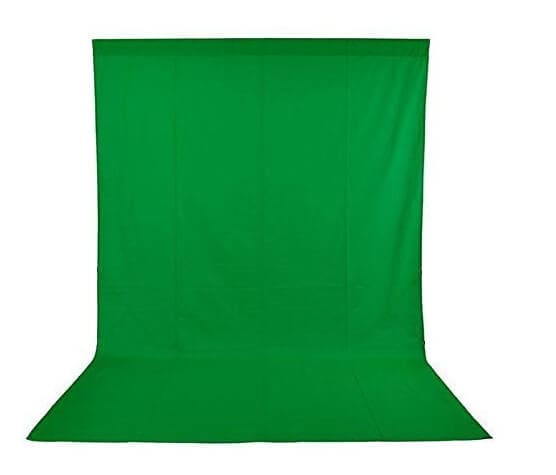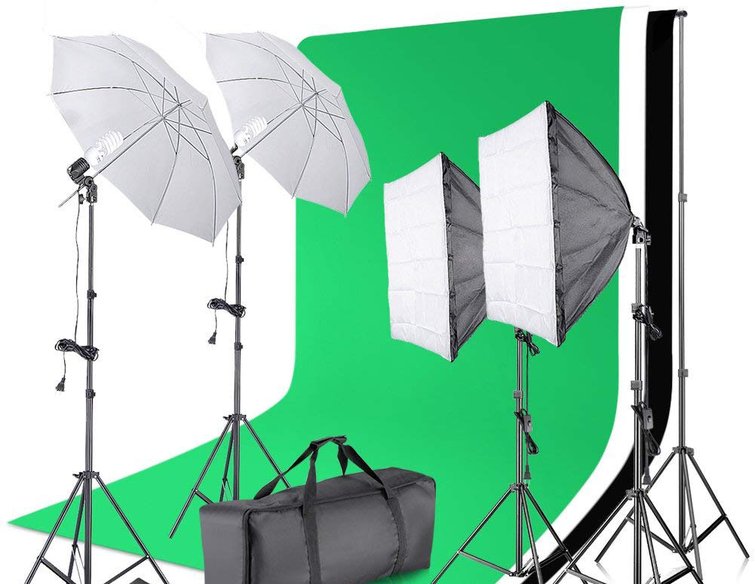A green screen is a key component in both amateur and professional filmmaking that allows one to create backdrops in place of the green color in the shot. Create your own green screen setup that is easy to make and easy to transport for any of your own filmmaking projects. Make videos with the best lighting using the included 8” LED ring light with 3 different color modes and 10 dimmable brightness settings; Capture your best angles with the adjustable smartphone holder and extendable tripod; Create custom backgrounds using the included green screen paired with your favorite editing app! Compatible with most. A green screen allows you to seamlessly blend animation with live action footage, which erases many of the limitations posed by low-budget films. How to Make Your Own Green Screen. While a professional green screen can be purchased for as little as $50, if your production is on a tight budget, it is just as easy to create your own green screen. The ePhoto Chromakey Kit (Click here to Check out the latest prices on Amazon) is perfect basic green screen kit. This 3 light kit with a 10X20 100% muslin works as expected. What makes this kit great for video, especially interviews, is that it comes with a top light used to add overhead light.
Hollywood studios use green screen to create all kinds of incredible special effects. Your local weatherperson uses it to look like they’re standing in front of a cool weather map.
But you don’t have to be a big-shot movie director or even a local TV station to enjoy the many benefits green screen (or, as it’s technically called — chroma key) offers.
In fact, all you need to make a professional-quality green screen video is a smartphone or webcam, some fabric, good video editing software, and a little know-how.
But we’re getting ahead of ourselves here. Before we get started on the how, let’s talk about the what and why.
What exactly is a green screen, and why would you ever want to use a green screen effect in your video?
What is green screen?
Using green screen in video replaces the background of a video with a digital or virtual background. It offers the most natural-looking way to integrate your subject into your video.
Instead of putting each visual element in its own frame (a la picture-in-picture), green screen lets you blend them. In fact, done correctly, you would never suspect they were two separate video streams.
In the most technical terms, green screen, blue screen, chroma key, chroma key compositing all refer to the same idea. Regardless of what you call it, it’s a post-production technique for compositing (layering) two images or video streams together based on color hues (chroma range).
In layperson’s terms, it’s superimposing one image or video stream over another so it looks like one image or stream.
Newscasting, motion picture, and video game industries love this technique, but anyone can use the green screen effect.
Given the current working conditions of most people during the global pandemic, it’s a safe bet you’ve had a Zoom meeting or two with coworkers or others who’ve had cool virtual backgrounds. Green screen is really the same concept, but will typically provide a more professional result.
Green screen has come a long way since Lawrence Butler won an academy award for his special effects in the 1940 film The Thief of Bagdad.
Back then, the process was quite complex. Adding green screen required a lot of time and highly specialized equipment.
Now, you can easily do it in the comfort of your own home with minimal equipment and technical skills.
Make professional-quality videos — no pro skills required!
Download a free trial of Camtasia and see how easy it can be to create amazing videos.
Why use green screen?
As noted above, you’ve likely seen a meteorologist use a green screen to report the weather. Meteorologists stand in front of the green screen point out specific parts of the forecast. But the green screen does more than provide clarity. It also allows them to personalize their broadcast and connect to their viewers.
Although you may not be detailing cold fronts from your desk, I’d bet you still have opportunities to connect with an audience at work. A green screen is a great option for adding a personal touch to lots of different types of videos.
Consider using it the next time you need to:
Chroma key (remember, that’s green screen’s “technical name”) is a big deal for anyone who needs to connect with viewers. When done well, a green screen can give your video a professional aesthetic on the cheap.Create an online training video by superimposing yourself over all or just part of the lesson. This is an instant upgrade over talking through a PowerPoint presentation — and it’s way more impressive than just doing picture-in-picture with your webcam.
Whether you want to make it look like you (or your video subject) is on the moon or an African safari — or you just want to obscure the drab or uninspiring walls of your office or home studio, green screen makes it easy.
And, you don’t need to build a fancy set or rent studio time. You can shoot your video anywhere and replace the background with a branded graphic, stock photo, or video element.
In fact, TechSmith Assets for Camtasia offers a huge library of potential backgrounds you can use!
How to create your own green screen background
To pull off this technique, all you need is a few things: A green or blue piece of cloth/fabric, a camera, lights, and some video editing software.
Step 1: Get a backdrop
First, get a piece of muslin cloth that’s a bright shade of green.
Avoid a color that matches your skin tone so you don’t blend into your background.


Blue screen backdrops are also available, but they can cause problems if the person on camera has blue eyes or clothes. If you don’t want to mess around with hanging a cloth, a collapsible green screen panel is a nice option.
This example from Amazon includes both a green and blue collapsible screen.
Since it’s not too big (5′ x 7′), it’s perfect for when you need to travel for a shoot. We’ll discuss shadows and more when we get into lighting. But for now, remember to stand as close to the backdrop as you can without casting a shadow on it. This is usually around two or three feet. Also, make sure to keep your hands close to your body. Any part of your arm or hand that extends past the backdrop will look cut off in your final video.
Build Your Own Green Screen Kits Free
Step 2: Pick your camera
Next, you’ll want to pick a camera or webcam that shoots HD quality video (720p or higher) at a decent frame rate (24 fps or above). Make sure your camera saves out files in a format your green screen software can import. We’ve had good success using an iPhone, but most any digital camcorder will work.
No matter what camera you choose, Camtasia makes it easy to import your video and make your edits.
When you’re just starting out, recording footage on your smartphone might seem daunting. We’ve put together some tips and advice for shooting videos on your mobile device. We cover everything you need to know about audio, shot composition, and lighting.
Step 3: Set up your lighting

The next step is optional but recommended. It may take a little trial and error to get it right, but you’ll love the results.
Shadows can be the enemy of great green screen video, so you want to be sure your background is as well-lit as possible. Use a flat green background. The flatter the green, the easier it will be to remove the screen.
Don’t worry too much about getting a perfectly lit set, though. The Remove a Color effect in Camtasia is quite forgiving of background shadows. Spend a few minutes tweaking the settings and you should be good.
More advanced lighting for green screen
If you’re having trouble getting the background to disappear or there’s a slight halo around the person, try to upgrade your lighting. The more even your lighting, the better the effect will be.
Build Your Own Green Screen Kits Hobby Lobby
The easiest thing to try is a couple of hardware store clamp-on work lights with high-output LED bulbs. You’ll also need something to clamp them on. Aim the lights so that the green screen doesn’t have dark areas or bright areas. Focus your efforts on the area directly behind the person you’re shooting. You’ll be able to crop out the excess space later.
To throw a lot of light, you need a few bulbs in each fixture. You could build your own video lighting rig for less than $100 (see video below). Or if you’re not into DIY projects, you can shop around for a video softbox. CowboyStudio is a good place to start. Look for “continuous lighting” as opposed to flash or strobe lighting.
Whether you buy or build, it’s best to use a diffusion filter for each light. That will help keep your lights from throwing shadows.
This quick video shows you how to build your own lighting kit on the cheap.
(You can also get a few tips of the trade for making your subjects look more natural.)
Build Your Own Green Screen Kits Home Depot
Not seeing the video? Watch it on YouTube…
Step 4: Get the right software

In the Camtasia video editor, you can remove your green screen with just a few clicks. In fact, Camtasia 2020 makes it easier than ever to create professional-quality videos — no pro skills required.
From easy-to-use and share video templates and themes to a wide variety of assets and resources to help you on your way, Camtasia 2020 takes the guesswork out of video creation and puts you and your team at ease.
Anyone can make a green screen video
Green screen video may seem intimidating and difficult, but with the right tools and a few tips and tricks, anyone can master this useful technique. Whether you’re making videos for 5 or 5,000 people, they’ll be amazed at the professional quality and engaging experience green screen provides.
Build Your Own Green Screen Kits Do-it-yourself
Make professional-quality videos — no pro skills required!
Download a free trial of Camtasia and see how easy it can be to create amazing videos.
Editor’s Note: This post was originally published in May 2012 and has been updated for accuracy and comprehensiveness.
Related Posts:
